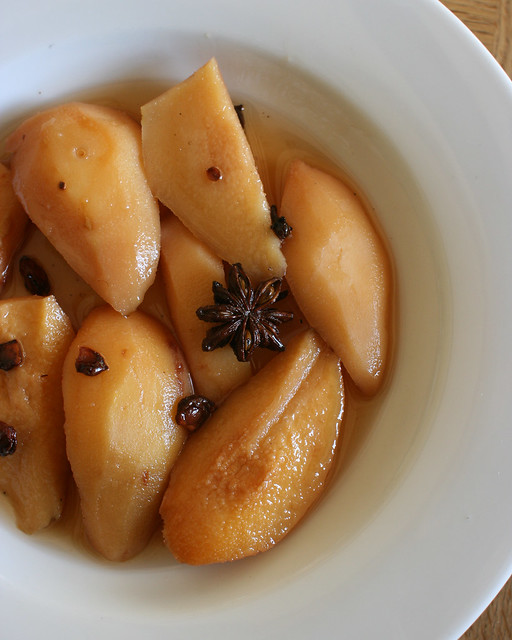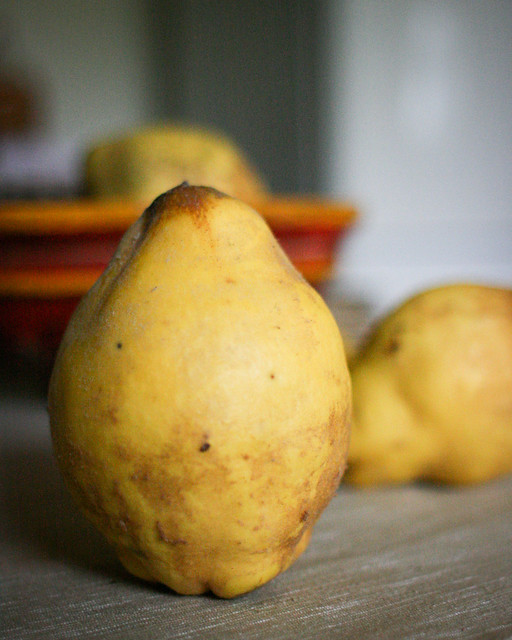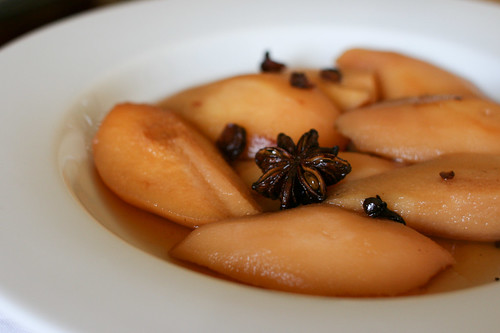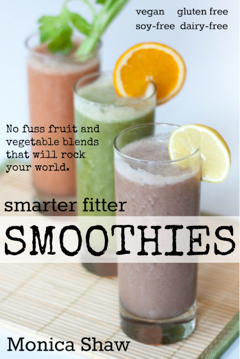The only thing I don’t like about quinces is the word itself. “Quince”, the word grates on my ears, much like the word “panties” or “moist”. Maybe it’s because I’m American, and I’m just not accustomed to the sound. Quinces are rare in North American due to its susceptibility to fireblight disease, but in England they flourish and seem to be very popular this time of year. They were first recorded in about 1275, when Edward I had some planted at the Tower of London and are still grown successfully as far north as Scotland.
I had my first quince two Fridays ago at Silvana de Soisson’s epic Foodie Bugle Lunch Party. Silvana has a bountiful quince tree. Some of those quinces made their appears at the dessert table, cooked in a spiced sugar syrup, delicious with the various cheeses making the rounds.
One of the highlights of the lunch was going outside and watching Silvana shake her quince tree, resulting in a rainfall of quinces (only one of which gave her dog a nasty bonk on the head).
And so, that’s how I ended up with six quinces and now that they’re here, I’ve gotten to know them a bit better.
Quinces are a very hard, astringent fruit that give off a strong but pleasant fruity aroma (potpourri be damned!). They are too hard and tart to eat raw, but they can be cooked into some amazing things, often jam, jelly or membrillo, the Spanish word for “quince” used to denote a fruit “cheese” classically served with Spanish sheep’s milk manchego cheese.
Quinces can also be stewed, baked or roasted, which is what I decided to do with three of mine using Nigel Slater’s recipe for roast quinces with star anise, cloves and maple syrup. Quinces require lots of sugar to cut through their tart astringency, but once roasted, they take on a soft, pear-like texture and a delicate flavour that works well with the warming spices. They were delicious for dessert last night with a bit of cream. I think they’d also be good for breakfast with muesli and yogurt.
All that’s left to do is get used to the word, because as much as I don’t like how “quince” sounds, I do love how they taste. For my last three quinces, I think some classic quince jam is in order. Thank you, Silvana.
Roast quinces
Adapted from Nigel Slater’s recipe for roast quinces. Before roasting, the quinces are poached in sugar and water so that the flesh becomes “melting and almost transparent”. You could also add something boozy to the mix. Stuart Vendent, also a recipient of Silvana’s quinces and an excellent food photographer, suggests Pineau des Charentes, port or sherry.
Ingredients
- 4 heaped tbsp sugar
- 500ml water
- 4 cloves
- 2 star anise
- 4 smallish quinces
- ½ a lemon
- 4 tbsp maple syrup
Method
- Put the sugar and water into a saucepan and bring to the boil. Add the cloves and star anise. Peel and halve the quinces and rub them with lemon to stop them browning.
- Lower the quinces into the sugar syrup and let them simmer till tender. They may be ready in 25 minutes or perhaps take a little longer, depending on their size and ripeness.
- Set the oven at 180C/gas mark 5. When they are tender to the point of a knife, lift the quinces out and put them in a shallow baking dish or roasting tin. Take150ml of the cooking liquid, add the maple syrup and, together with the aromatics, pour over the quinces.
- Bake for 30 minute or so till very soft and tender. Serve with their cooking juices.
Prep Time: 20 minutes
Cook time: 60 minutes





I’ve always wanted to try quince, but haven’t ever found it imported. Roasting them sounds perfect–especially with the star anise!
I can think of a lot of fruits that would be delicious roasted with star anise. 🙂